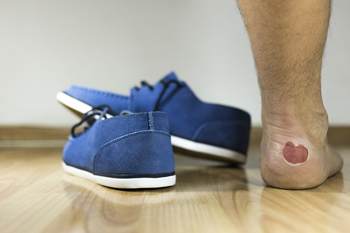
A friction blister is a repetitive injury, usually the result of doing a motion that threatens the skin. Feet and toes are among the most common sites for friction blisters. Pressure, friction, and damp or moist skin create the prime environment for a friction blister formation. For instance, a runner or hiker wearing new or stiff shoes but no moisture-wicking socks may be at risk. These factors may result in the separation of skin layers, causing a plasma-like fluid to build up under the top layer in an effort to protect those beneath it. What you will see is a bubble-like formation on the skin. The normal reaction is to pop it and drain the fluid, but that action could lead to more pain and possible infection. The fluid bubble is considered sterile, and experts recommend leaving it alone. Blisters will usually go away on their own if you cease the harming action. A protective, donut-shaped pad, to protect the site, may help. However, if the friction blister site becomes red and swollen, and emits an odor, it may be infected. In that case, it is wise to consult a podiatrist as soon as possible for treatment.
Blisters are prone to making everyday activities extremely uncomfortable. If your feet are hurting, contact Afsaneh Latifi, DPM of Lenox Hill Podiatry. Our doctor can provide the care you need to keep you pain-free and on your feet.
Foot Blisters
Foot blisters develop as a result of constantly wearing tight or ill-fitting footwear. This happens due to the constant rubbing from the shoe, which can often lead to pain.
What Are Foot Blisters?
A foot blister is a small fluid-filled pocket that forms on the upper-most layer of the skin. Blisters are filled with clear fluid and can lead to blood drainage or pus if the area becomes infected.
How Do Blisters Form?
Blisters on the feet are often the result of constant friction of skin and material, usually by shoe rubbing. Walking in sandals, boots, or shoes that don’t fit properly for long periods of time can result in a blister. Having consistent foot moisture and humidity can easily lead to blister formation.
Prevention & Treatment
It is important to properly care for the affected area in order to prevent infection and ease the pain. Do not lance the blister and use a Band-Aid to provide pain relief. Also, be sure to keep your feet dry and wear proper fitting shoes. If you see blood or pus in a blister, seek assistance from a podiatrist.
If you have any questions, please feel free to contact our office located in New York, NY . We offer the newest diagnostic and treatment technologies for all your foot care needs.




